“The only way to solve a conflict at any level of society is to sit down face to face and talk about it.” (John W. McDonald)
 Today most wars are intrastate ethnic conflicts. However it is important is to put single conflicts in wider context such as game between great powers, struggle over global energy resources and their supply routes, economic profits of military-industrial-complex etc. From my point of view current peacemaking, peace-building or crisis management structures are not designed to cope with this type of conflict so a deeper holistic approach is needed to make more sustainable solutions.
Today most wars are intrastate ethnic conflicts. However it is important is to put single conflicts in wider context such as game between great powers, struggle over global energy resources and their supply routes, economic profits of military-industrial-complex etc. From my point of view current peacemaking, peace-building or crisis management structures are not designed to cope with this type of conflict so a deeper holistic approach is needed to make more sustainable solutions.
The British think-tank BICOM, has released its new report on Israeli-Palestinian peacebuilding projects in Israel and the West Bank. The report finds that grassroots Israeli-Palestinian peace building projects work and are a vital missing ingredient in the Israeli-Palestinian peace process. The report is the first of its kind to attempt a comprehensive review of peacebuilding projects in this area, looking at over 20 years of evaluation data, and based on extensive field work. [my review about report in article A future for Israeli-Palestinian peacebuilding: The report By BICOM ]
Below I try present brief wider context about peacebuilding and – inspired by report mentioned -conclude the key components of a holistic approach of peacemaking.
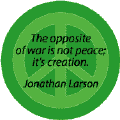
The context
I think it is important define also peace mediation and different aspects of that. In my opinion the conflict resolution by most peacemakers is an ad hock fire department activity, important but secondary question. The primary issue from my viewpoint is prevention of problems and their causes, or at least awareness of them. So peace mediation is one part of handling conflicts, it should be applied also before armed conflicts, also post-conflict crisis management in short term and seeking sustainable solutions in long term should be integral part of peace mediation and its training activities.
In my article in Peacemaking – How about solving Conflicts too? I described four traditional ways in which conflicts between two parties are handled:
- A wins, B loses;
- B wins, A loses;
- the solution is postponed because neither A nor B feels ready to end the conflict;
- a confused compromise is reached, which neither A nor B are happy with.
These traditional methods have at least following shortages:
 Basically peace deals are made between elite’s and their (game) interests where participants are calculating are the wins due the peace bigger than the wins due the war.
Basically peace deals are made between elite’s and their (game) interests where participants are calculating are the wins due the peace bigger than the wins due the war.- Many times the process is coercive based to will of outsiders not necessary local needs.
- In my opinion the traditional process will produce temporary – tactical – solutions and the outcome is frozen conflict. The best examples of these are maybe Bosnia after Dayton and Kosovo after Ahtisaari’s pseudo talks.
As alternatives for these traditional methods I have found three better approach [sure there is more but these three are good examples]:
- Multi-Track Diplomacy by The Institute for Multi-Track Diplomacy (more from link),
- Holistic Integrated Model of Peacebuilding (justpeace) by Peacebuilders International (more from link), and especially
- TRANSCEND method by Johan Galtung
Galtung himself has employed the “TRANSCEND” Method while serving as a negotiator in a number of international conflicts. He tries to break with four unsatisfactory ways – mentioned earlier – of handling a conflict by finding a “fifth way,” where both A and B feel that they win. He views his role as that of helping the parties clarify their objectives, and working to come up with solutions that meet the objectives of all parties. He presents them with concrete proposals that are intended to give both sides the sense that they are winners. TRANSCEND’s “conflict transformation” approach relies on nonviolence, creativity, and empathy to facilitate an outcome where both parties move beyond their stated positions to create a new reality in their relationship. [more in Johan Galtung’s Conflict Transformation Theory]
I think that “Transcend” approach hits the core question in peace-building process. First it is based to wide participation and even commitment of local stakeholders through dialogue, second it goes to the roots of conflicts and third it is future-oriented.
Peacemaking – a holistic approach
“…long-term grassroots peacebuilding between the contending parties is always essential to achieving peace.” ((Jonathan Powell, the chief British negotiator during the Northern Ireland Peace Process )
In my opinion peacemaking is only secondary action by managing conflicts – a deeper holistic approach is needed to make more sustainable solutions. The main components from my viewpoint opinion are the following:
- An approach of active or creative peace-building should be applied to achieve long term solutions
- Dialogue between local stakeholders is the key component in peace-building process as if the parties are willing to discuss the conflict and work toward reaching a holistic resolution the outcome may be sustainable.
- Dialogue should be applied through high, middle-range and grassroots levels horizontally across the lines of division in a society. There should also be no gap of interdependence of coordinated relationships up and down the levels of leadership in a society – the vertical capacity means developing relationships between higher and grassroots levels of leadership.
- To understand the true nature of security issues in each particular context it is necessary to apply also a non-western theoretical framework as the non-western social, political and cultural reality demands maybe different approach – or viewpoint – than normal western practice.
- Creating an environment of lasting peace is the primary goal of peace-building. The main tool can be different creative therapies being used to create peace, within individuals, groups, and societies. Although used primarily to overcome violence, creative peace-building can also be used as a preventative measure to make the foundations of peace stronger, especially when used with children.
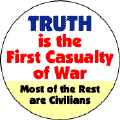 The value of civilians in post-conflict stabilization has become increasingly clear and should be appreciated at the expense of military alternatives. Dialogue-based interventions will enhance the motivation and capacity of participants to become “agents of change” in their communities so encouraging long-term engagement in peacebuilding.
The value of civilians in post-conflict stabilization has become increasingly clear and should be appreciated at the expense of military alternatives. Dialogue-based interventions will enhance the motivation and capacity of participants to become “agents of change” in their communities so encouraging long-term engagement in peacebuilding.

My related articles:
R2P vs Facades of Interventions,
Multifaceted Intervention Practices ,
Is Peace more than absence of the War? ,
Appendix: Some of my related infographs:
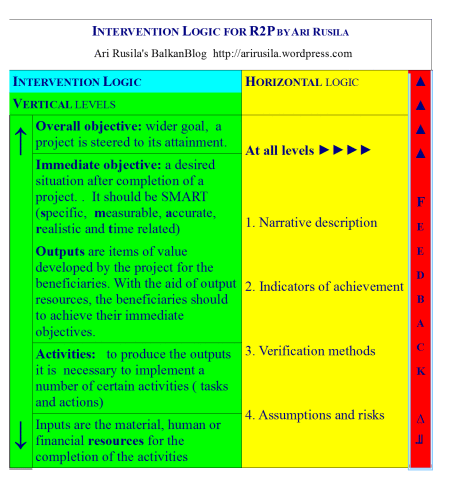
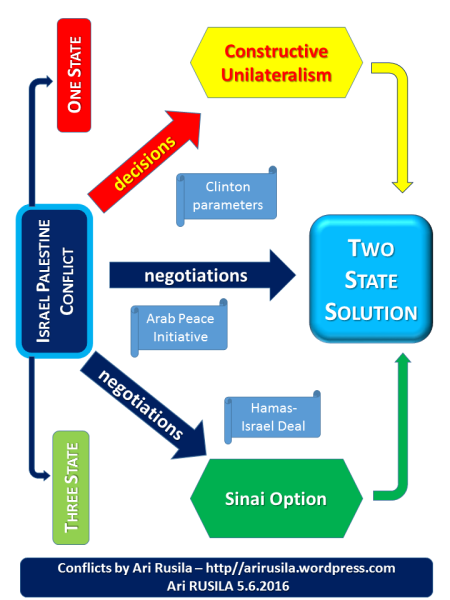
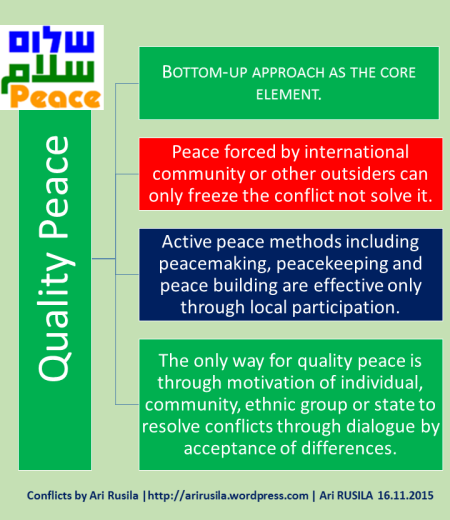
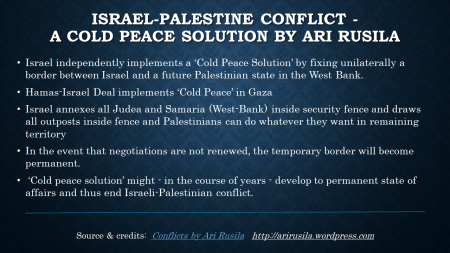
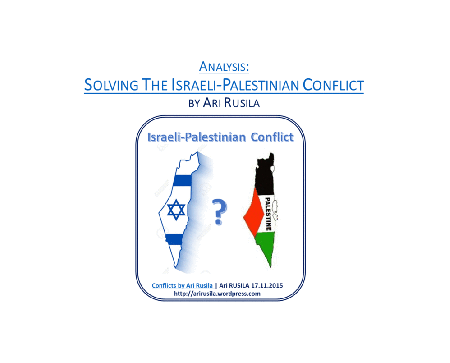
Solving Israeli-Palestinian Conflict by Ari Rusila – https://arirusila.wordpress.com
" data-orig-size="998,805" data-image-title="www.GIFCreator.me_euPboX" data-orig-file="https://arirusila.files.wordpress.com/2015/12/wwwcreator-me_eupbox.gif" data-image-meta="{"aperture":"0","credit":"","camera":"","caption":"","created_timestamp":"0","copyright":"","focal_length":"0","iso":"0","shutter_speed":"0","title":"","orientation":"0"}" width="450" data-medium-file="https://arirusila.files.wordpress.com/2015/12/wwwcreator-me_eupbox.gif?w=300" data-permalink="https://arirusila.wordpress.com/2015/12/24/animation-solving-israeli-palestinian-conflict-by-ari-rusila/www-gifcreator-me_eupbox/" alt="Solving Israeli-Palestinian Conflict by Ari Rusila - https://arirusila.wordpress.com" height="363" class="size-large wp-image-4952" data-large-file="https://arirusila.files.wordpress.com/2015/12/wwwcreator-me_eupbox.gif?w=450&h;=363" />Solving Israeli-Palestinian Conflict by Ari Rusila – https://arirusila.wordpress.com
Advertisements Basically peace deals are made between elite’s and their (game) interests where participants are calculating are the wins due the peace bigger than the wins due the war.
Basically peace deals are made between elite’s and their (game) interests where participants are calculating are the wins due the peace bigger than the wins due the war.
